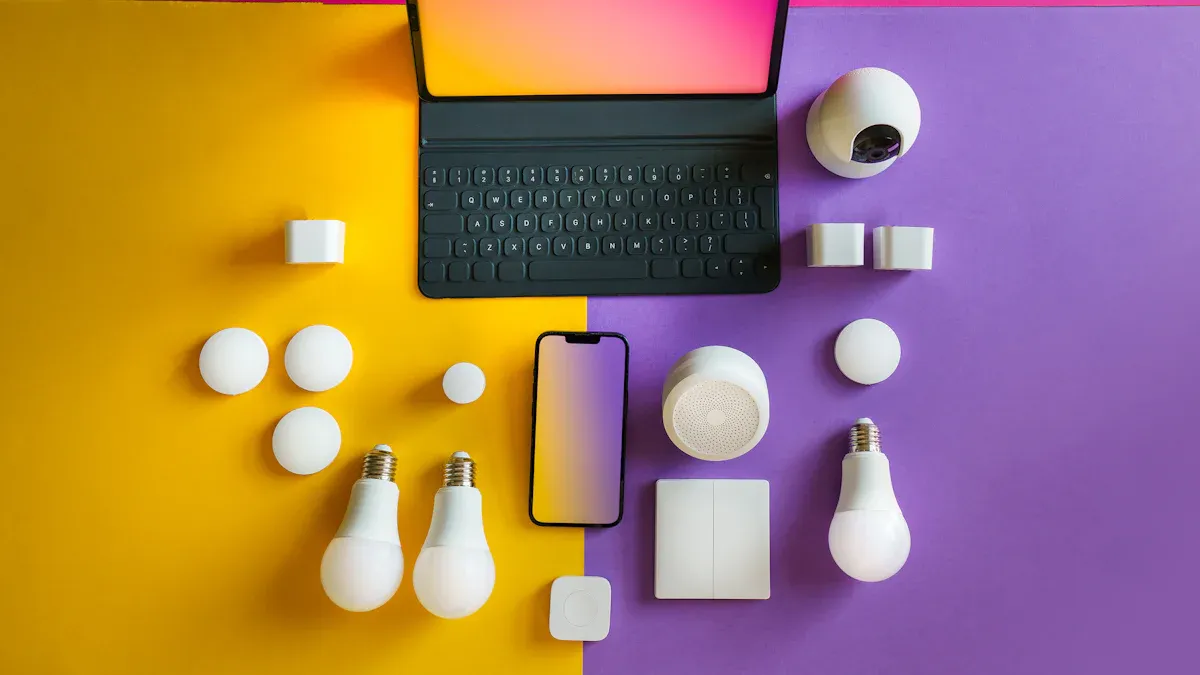How to Maximize Flashlight Performance with Proper Battery Usage

Have you ever noticed how the right battery can completely change your flashlight using experience? It’s not just about turning on the light. The performance of your flashlight depends on the battery you choose. A good battery ensures brightness, longer runtime, and safety. Using a flashlight with the wrong battery can reduce its optimal performance and even cause damage. Proper care keeps your flashlight reliable and ready when you need it most.
Key Takeaways
Pick the correct battery for your flashlight. Alkaline batteries are good for rare use. Lithium or rechargeable ones are better for daily use.
Store batteries the right way to avoid leaks. Keep them in a cool, dry spot. Take them out of the flashlight if not using it for a while.
Check batteries often for damage. Look for swelling or cracks. Replace damaged batteries right away to stay safe.
Battery Types and Their Impact on Flashlight Performance

Alkaline Batteries: Affordable but Limited
Alkaline batteries are one of the most common types of flashlight batteries. You’ll find them affordable and easy to purchase almost anywhere. However, they have their limitations.
They work well for low-drain flashlights but struggle in high-drain situations.
Their runtime is shorter compared to lithium or rechargeable batteries.
They can leak if stored improperly, which might damage your flashlight.
If you’re using a flashlight occasionally, alkaline batteries might be a good choice. But for frequent use, you’ll want something more reliable.
Lithium Batteries: High Performance and Versatility
Lithium batteries play a significant role in flashlights, especially when you need high performance. They offer higher voltage output, which enhances light output and ensures longer-lasting brightness. These batteries are also lightweight and perform well in extreme temperatures, making them ideal for outdoor adventures.
You’ll notice that lithium batteries come in various sizes, such as 18650 and 21700, which are popular for LED flashlights. While they cost more than alkaline batteries, their longevity and power make them worth the investment.
Rechargeable Batteries: Cost-Effective and Eco-Friendly
Rechargeable batteries are a fantastic option if you want to save money and reduce waste. They’re reusable, which means you won’t need to buy replacements as often.
"Their longer lifespan compared to traditional batteries reduces the frequency of replacement, indirectly contributing to waste reduction. Furthermore, they're instrumental in our transition towards renewable energy, as they store excess energy produced by wind and solar power, ensuring a steady supply even during periods of low energy production."
Rechargeable batteries, like NiMH or Li-ion, are perfect for frequent flashlight users. They’re also great for the environment, making them a win-win choice.
Specialty Batteries: When to Use Them
Sometimes, you’ll need specialty batteries for specific flashlight applications. These batteries are designed for unique needs, such as high energy output or extended use.
Battery Type | Application in Flashlights |
|---|---|
Lithium Iron Phosphate (LiFePO4) | High energy output for bright settings and extended use |
Specialty batteries are less common but essential for certain flashlights. If your flashlight requires one, always follow the manufacturer’s recommendations to ensure optimal performance.
How to Select the Right Flashlight Battery
Follow Manufacturer Recommendations
When it comes to flashlight batteries, following the manufacturer’s recommendations is the best way to ensure compatibility and performance. Manufacturers design their flashlights with specific battery requirements in mind. Ignoring these can lead to poor runtime or even damage.
Here’s what you should check:
Battery Size and Compatibility: Make sure the battery fits your flashlight perfectly.
Discharge Current and C-Rating: Confirm the battery can handle the power demands of your flashlight.
Battery Capacity: Higher capacity batteries last longer, giving you more runtime.
Battery Internal Resistance: Lower resistance means better performance.
Flat-top or Button-top: Use the correct type for your flashlight.
Protection Circuits: Choose protected batteries for safety unless your flashlight requires high-drain power.
By sticking to these guidelines, you’ll avoid unnecessary issues and maximize your flashlight’s runtime.
Match Battery Type to Flashlight Usage
Not all flashlights are the same, and neither are their batteries. Selecting batteries based on flashlight type is crucial. For occasional use, alkaline batteries might work fine. If you need consistent performance, lithium or rechargeable batteries are better options.
Think about how you use your flashlight. For outdoor adventures, lithium batteries are ideal because they perform well in extreme conditions. For daily use, rechargeable batteries save money and reduce waste. Matching the battery to your flashlight’s purpose ensures you get the most out of it.
Consider Runtime and Power Needs
Runtime and power go hand in hand. If you rely on your flashlight for extended periods, you’ll need a battery with a high capacity. Lithium batteries are excellent for this, as they provide consistent power over time. Rechargeable batteries also offer great runtime, especially for frequent users.
For flashlights with adjustable brightness settings, consider how much power each mode consumes. Lower settings extend runtime, while higher settings drain the battery faster. Understanding your flashlight’s power needs helps you choose the right battery for the expected usage time.
Environmental Factors: Cold and Humid Conditions
Environmental conditions can affect battery performance significantly. Cold weather, for example, reduces the efficiency of lithium batteries. They may struggle to function below -40°F. Metal flashlights can also become uncomfortable to hold in freezing temperatures, and poor electrical contact might occur due to metal contraction.
Humidity poses its own challenges. Moisture can freeze inside your flashlight, leading to short circuits. To combat these issues, store your flashlight in a dry place and use LED bulbs, which are less likely to break in extreme conditions. Preparing for environmental factors ensures your flashlight stays reliable when you need it most.
Battery Maintenance and Safety Tips

Proper Storage to Avoid Leaks
Storing batteries correctly is essential to maintain the health of your flashlight battery and prevent leaks. Follow these best practices to ensure your batteries stay in top condition:
Keep batteries in a cool, dry place, away from direct sunlight and extreme temperatures.
Remove batteries from your flashlight if you won’t use it for a long time. This prevents leaks and corrosion.
Avoid mixing different battery types or brands, as this can cause uneven power discharge.
Regularly check for expiration dates and signs of leakage.
By following these steps, you’ll protect your flashlight and extend the longevity of your batteries.
Prevent Overcharging and Over-discharging
Overcharging or over-discharging batteries can harm their performance and lifespan. Overcharging causes overheating, which may lead to swelling, leaks, or even explosions. On the other hand, over-discharging reduces capacity and can cause battery failure. Use chargers with built-in safety features to avoid these issues. Rechargeable batteries, like lithium-ion, are especially sensitive to improper charging, so always follow the manufacturer’s guidelines.
Inspect Batteries for Damage
Damaged batteries can compromise your flashlight’s performance and safety. During inspections, look for these warning signs:
Cracks or visible damage to the casing.
A rotten egg smell, which indicates internal damage.
Batteries that don’t hold a charge above 75%.
If you notice any of these issues, replace the battery immediately to avoid further problems.
Dispose of Batteries Responsibly
Proper disposal of batteries is crucial for safety and the environment. Never throw batteries in the trash, as they contain harmful materials. Instead, follow these steps:
Identify the battery type and locate a recycling drop-off point.
Cover the terminals with tape to prevent short circuits.
Follow the instructions at the disposal site.
Recycling batteries recovers valuable materials like lithium and cobalt, reducing the need for new raw materials. It’s a small step that makes a big difference for the planet.
Maximizing Flashlight Runtime and Lifespan
Use Energy-Saving Settings
Using energy-saving settings can significantly improve your flashlight's performance and battery longevity. Many modern flashlights come equipped with LED lights, which are far more efficient than traditional incandescent bulbs. They consume less power while providing excellent brightness. If your flashlight offers multiple brightness levels, switch to a lower setting when full brightness isn’t necessary. This simple adjustment can extend runtime, especially during outdoor activities like camping. Some flashlights even feature automatic shutoff functions, which conserve battery power by turning off the light after a period of inactivity. These features ensure you get the most out of your flashlight without compromising its performance.
Turn Off Flashlight When Not in Use
It’s easy to forget to turn off your flashlight when you’re not using it. However, leaving it on unnecessarily drains the battery and reduces its lifespan. Make it a habit to switch off your flashlight as soon as you’re done. Whether you’re hiking, camping, or just using it around the house, this small step can make a big difference. If your flashlight has a lockout mode, use it to prevent accidental activation during storage or transport. This simple practice helps preserve battery power and ensures your flashlight is ready when you need it most.
Rotate Batteries for Even Wear
Rotating your batteries is another effective way to maximize their longevity. If you use rechargeable batteries, this becomes even more important. Batteries tend to wear unevenly when used in pairs or groups. By swapping their positions regularly, you can ensure even wear and maintain consistent performance. This practice is especially useful for flashlights that require multiple batteries. It not only extends battery life but also prevents one battery from overworking, which could lead to reduced performance or damage.
Keep Spare Batteries for Emergencies
Always keep spare batteries on hand, especially if you’re heading outdoors. Whether you’re camping, hiking, or exploring, having extra batteries ensures you won’t be left in the dark. Choose rechargeable batteries for frequent use, as they’re cost-effective and eco-friendly. For outdoor adventures, lithium batteries are a great choice because they perform well in extreme conditions. Store your spare batteries in a cool, dry place and check them regularly for damage. Being prepared with backups guarantees reliable flashlight performance, no matter the situation.
Choosing the right battery makes a big difference in your flashlight’s performance. It affects brightness, runtime, and reliability. Always consider your flashlight’s specific needs, like battery size, life, and how it performs in different environments. For cold climates, lithium batteries are a great choice.
Taking care of your batteries also keeps your flashlight working longer. Wipe it down regularly to remove dirt. Check the battery contacts for corrosion and clean them with rubbing alcohol. Inspect the seals to ensure waterproofing. These small steps help maintain reliable performance and extend the lifespan of your flashlight and its batteries.
By following these tips, you’ll enjoy a dependable light source that’s ready whenever you need it.
FAQ
What type of battery is best for a flashlight?
It depends on your needs. For occasional use, alkaline batteries work fine. For frequent or outdoor use, lithium or rechargeable batteries perform better and last longer.
How can I prevent flashlight batteries from leaking?
Store them in a cool, dry place. Remove them if you won’t use the flashlight for a while. Check for damage or expiration regularly.
Why does my flashlight dim even with new batteries?
This happens when the flashlight’s contacts are dirty or corroded. Clean them with rubbing alcohol. If the issue persists, check the bulb or battery compatibility.
See Also
Maximize Your Flashlight's Battery Life With These Tips
Key Strategies for Proper Flashlight Care and Maintenance
Increase Your Flashlight's Lifespan For Extended Usage
